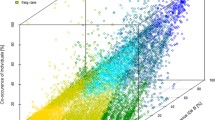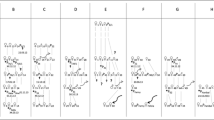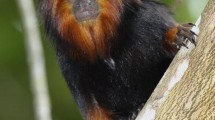Summary
We examined demographic effects of familiarity and relatedness in the bank vole Clethrionomys glareolus (Schreber) in four 0.5-ha enclosures in Central Finland. In two enclosures were mature voles which had overwintered together and some of their mature off-spring (hereafter referred to as “Friends”), and in the other two individuals of the same species captured from different localities near the study area (“Strangers”). The experiment lasted from June to September. The populations of Friends reached densities twice as high as those of Strangers with a significantly higher rate of recruitment and survival of the young. This may have been due to mutual familiarity decreasing antagonism towards the juveniles. The conflicting results obtained from studies of Clethrionomys and Microtus are discussed. We believe that these genera represent behavioural adaptations to different habitats and ways of life. Most behavioural population regulation hypotheses are based on studies of Microtus. We conclude that these results should be applied with great caution to other rodent genera.
Similar content being viewed by others
References
Armitage KB (1984) Recruitment in Yellow-bellied marmot populations: Kinship, philopatry, and individual variability. In: Murie JO, Michner GR (eds) The biology of ground-dwelling squirrels. Univ Nebraska Press, Lincoln, pp 377–403
Armitage KB (1986) Individually, social behaviour and reproductive success in yellow-bellied marmots. Ecology 67: 1186–1193
Boonstra R (1984) Aggressive behaviour of adult meadow voles (Microtus pennsylvanicus) towards young. Oecologia (Berlin) 62: 126–131
Boonstra R (1985) Demography of Microtus pennsylvanicus in Southern Ontario: enumeration versus Jolly-Seber estimation compared. Can J Zool 63: 1174–1180
Boonstra R, Craine ITM (1986) Natal nest location and small mammal tracking with a spool-and-line technique. Can J Zool 64: 1034–1036
Boonstra R, Hogg I (1988) Friends and Strangers: a test of the Charnov-Finerty Hypothesis. Oecologia (Berlin) 77: 95–100
Boonstra R, Krebs CJ (1977) Fencing experiment on a high-density population of Microtus townsendii. Can J Zool 55: 1166–1175
Boonstra R, Krebs CJ, Gaines MS, Johnson ML, Craine ITM (1987) Natal philopatry and breeding systems in voles (Microtus spp.). J Anim Ecol 52: 757–784
Bruce HM (1960) A block to pregnancy in the mouse caused by proximity of strange males. J Repr Fertil 1: 96–103
Bujalska G (1970) Reproduction stabilizing elements in an island population of Clethrionomys glareolus (Schreber 1780). Acta Theriol 15: 381–412
Bujalska G (1973) The role of spacing behaviour among females in the regulation of the reproduction in the bank vole. J Repr Fertl Suppl 19: 465–474
Caley MJ, Boutin SA (1987) Sibling and neighbour recognition in wild juvenile muskrats. Anim Behav 35: 60–66
Charnov EL, Finerty JP (1980) Vole population cycles: a case for skin-selection?. Oecologia (Berlin) 45: 1–2
Clulow FV, Clarke JR (1964) Pregnancy block in Microtus agrestis, an induced ovulator. Nature (London) 219: 511
Clulow FV, Mallory FF (1970) Oestrus and induced ovulation in the meadow vole, Microtus pennsylvanicus. J Repr Fertil 23: 341–343
Crowcroft P, Rowe P (1957) The growth of confined colonies of the wild house mouse (Mus musculus L.). Proc Zool Soc London 129: 359–370
Croweroft P, Rowe P (1963) Social organization and territorial behaviour in wild house mouse (Mus musculus L.). Proc Zool Soc London 140: 517–531
Erlinge S, Göransson G, Hansson L, Högstedt G, Liberg O, Nilsson IN, Nilsson T, von Schanz T, Sylven M (1983) Predation as a regulating factor on small rodent populations in southern Sweden. Oikos 40: 36–52
Ferkin MH (1988a) Seasonal differences in social behavior among adult and juvenile meadow voles Microtus pennsylvanicus.Ethology 79: 116–125
Ferkin MH (1988b) The effect of familiarity on social interactions in meadow voles, Microtus pennsylvanicus: a laboratory and field study. Anim Behav 36: 1816–1822
Frank F (1953) Zur Entstehung übernormaler Populationsdichten im Massenwechsel der Feldmaus, Microtus arvalis (Pallas). Zool Jb Syst 81: 611–624
Frank F (1954) Beiträge zur Biologie der Feldmanus, Microtus arvalis (Pallas). Teil I: Gehegeversuche. Zool Jb Syst 82: 354–404
Gaines MS, McClenaghan LR Jr (1980) Disperasal in small mammals. Ann Rev Ecol Syst 11: 163–196
Gavish L, Hofmann JE, Getz LL (1984) Sibling recognation in the prairie vole, Microtus ochrogaster. Anim Behav 32: 362–366
Halpin ZT (1976) The role of individual recognition by odors in the social interactions of the Mongolian gerbil (Meriones unguiculatus). Behaviour 58: 117–130
Halpin ZT (1980) Individual odors and individual recognition: review and commentary. Biol Behav 5: 233–248
Hansson L (1987) An interpretation of rodent dynamics as due to trophic interactions. Oikos 50: 308–318
Hansson L, Henttonen H (1988) Rodent dynamics as community process. TREE 3: 195–200
Henttonen H (1986) Causes and geographic patterns of microtine cycles. PhD Thesis University of Helsinki, Finland
Heske EJ, Ostfeld RS, Lidicker WZ Jr (1988) Does social behaviour drive vole cycles? An evaluation of competing models as they pertain to California voles. Can J Zool 66: 1153–1159
Kalela O (1957) Regulation of reproduction rate in subarctic populations of the vole Clethrionomys rufocanus (Sund.). Ann Acad Sci Fennicae (A IV) 34: 1–60
Kalela O, Koponen T, Yli-Pietilä M (1971) Übersicht über das Vorkommen von Kleinsäugern auf verschiedenen Wald- und Moortypen Nordfinnllnds. Ann Acad Sci Fenniae (A IV) 185: 1–13
Kalkowski W (1967) Olfactory bases of social orientation in the white mice. Folia Biol 15: 69–87
Kawata M (1987) The effect of kinship on spacing among female red-backed voles, Clethrionomys rufocanus bedfordiae. Oecologia (Berlin) 72: 115–122
Krebs CJ, Keller BL, Tamarin RH (1969) Microtus population biology: demographic changes in fluctuating populations of M. ochrogaster and M. pennsylvanicus in southern Indiana. Ecology 50: 587–607
Krebs CJ, Gaines MS, Keller BL, Myers JH, Tamarin RH (1973) Population cycles in small rodents. Science 179: 35–41
Lidicker WZ Jr (1988) Solving the enigma of microtine “cycles” J Mamm 69: 225–235
Mallory FF, Brooks RJ (1980) Infanticide and pregnancy failure: reproductive strategies in the female collared lemming (Dicrostonyx groenlandicus). Biol Reprod 22: 192–196
Myllymäki A (1970) Population ecology and its application to the control of the field vole, Microtus agrestis (L.). EPPO Publ (Ser A) 58: 27–48
Porter RH, Matochik JA, Makin JW (1984) The role of familiarity in the development of social preferences in spiny mice. Behav Processes 9: 241–254
Rodd HF, Boonstra R (1988) Effect of adult meadow voles, Microtus pennsylvanicus, on young conspecifics in field populations. J Anim Ecol 57: 755–770
Rowe FP, Redfern R (1969) Aggressive behaviour in related and unrelated wild house mice (Mus musculus L.). Ann Appl Biol 64: 425–431
Saitoh T (1981) Control of female maturation in high density populations of the red-backed vole, Clethrionomys rufocanus bedfordiae. J Anim Ecol 50: 79–87
Stenseth NC, Bondrup-Nielsen S, Ims RA (1988) A population dynamics model for Clethrionomys: sexual maturation, spacing behaviour and dispersal. Oikos 52: 186–193
Viitala J (1977) Social organization in cyclic subarctic populations of the voles Clethrionomys rufocanus (Sund.) and Microtus agrestis (L.). Ann Zool Fennici 14: 53–93
Viitala J, Hoffmeyer I (1985) Social organization in Clethrionomys compared with Microtus and Apodemus: Social odours, chemistry and biological effects. Ann Zool Fennici 22: 359–371
Wilkinson GS, Baker AEM (1988) Communal nesting among genetically similar house mice. Ethology 77: 103–114
Ylönen H (1990) Spatial avoidance between the bank vole Clethrionomys glareolus and the harvest mouse Micromys minutus. Ann Zool Fennici (in press)
Ylönen H, Viitala J (1985) Social organization of an enclosed winter population of the bank vole Clethrionomys glareolus. Ann Zool Fennici 22: 353–358
Ylönen H, Viitala J (1990) Social overwintering and food distribution in the bank vole Clethrionomys glareolus. Halarct Ecol (in press)
Ylönen H, Kojola T, Viitala J (1983) Changing female spacing behaviour and demography in an enclosed breeding population of Clethrionomys glareolus. Holarct Ecol 11: 286–292
Author information
Authors and Affiliations
Rights and permissions
About this article
Cite this article
Ylönen, H., Mappes, T. & Viitala, J. Different demography of friends and strangers: an experiment on the impact of kinship and familiarity in Clethrionomys glareolus . Oecologia 83, 333–337 (1990). https://doi.org/10.1007/BF00317556
Received:
Accepted:
Issue Date:
DOI: https://doi.org/10.1007/BF00317556




